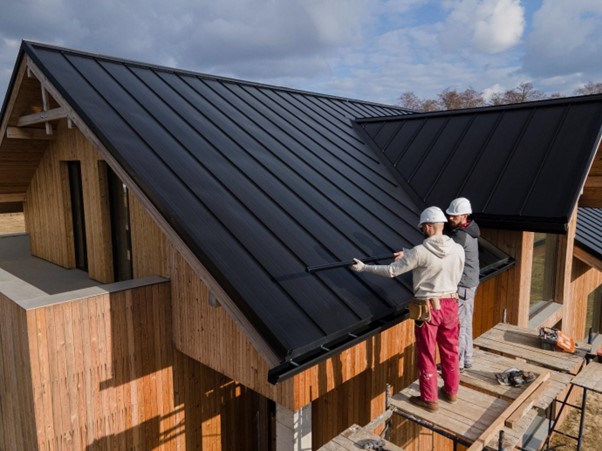Roof Restoration vs Replacement: Which One is Better? The opinions expressed by the author in this and all guest blogs are not necessarily those of Gainesville Restoration and Remodeling.
Keeping the roof in good shape is a massive deal for anyone owning properties like apartment buildings, shopping malls, or fancy penthouses. As roofs get up there in age, you will notice issues popping up like leaks or sagging spots.
At some point, you must decide whether shelling out the cash to replace the roof entirely is worth it or if you can get by just restoring the roof to squeeze out some more years before a total swap. Both options have their upsides and downsides regarding budget and lifespan. Knowing the main differences can help make the best call for your property.

Roof Restoration vs Replacement: Which One is Better?
Roof Budgeting
The costs of restoring an existing roof and doing a complete tear-off replacement can vary significantly. Roof restorations that involve surface repairs and coatings are less expensive upfront than full replacements, which require installing all new materials. Variables like roof size, materials, layers, permitting and assessments also impact costs. Total costs can be high for large commercial re-roofing projects.
Suppose more than 25% seems degraded or the original materials are nearing expected lifespan limits of around 20 years. In that case, replacement provides more muscular water tightness and long-term financial returns over continual repairs and moderate restoration grants extra valuable years as a budget-conscious maintenance option.
Getting estimates from real estate companies for both fixes allows owners to weigh costs against durability in selecting the optimal approach.
Roof Restoration Benefits
For roofs with sound structural framing just needing surface refreshing, restoration proves a lightweight rejuvenation approach offering advantages like:
Sustainability
Preserving 80-90% of existing roof materials keeps tons of tiles, shingles, and tar out of landfills during replacements, reducing waste and aiding environmental goals.
Architectural Preservation
Historic buildings often showcase unique slate, tile or cedar shake profiles that would prove cost-prohibitive for most owners to replicate with complete custom replacement. Surface restoration allows for maintaining such original, distinctive designs.
Tenant Disruptions
Without intensive demolition, dusty debris, and noisy work, surface-level roof restoration allows normal interior operations with fewer disturbances.
Top Restoration Candidates
The best candidates for roof restoration rather than complete replacement are buildings with roofs under 25 years old that have sustained only minor weathering damage and still have structurally sound framing and previous repairs that have lasted 5+ years.
Prime examples include:
- older apartment complexes and quarters where replacement costs would be prohibitive,
- historic buildings with rare roof profiles that are costly to reproduce, and
- individual retail locations with short remaining lease terms that do not warrant major capital expenditures.
Limitations of Roof Restoration
While beneficial in the short and mid-term, restoration eventually falls short for commercial owners prioritizing advanced water protection, energy efficiency, and property value boosts over 20+ year hold periods.
Specific downsides consist of the following:
Lifespan
The lifespan after restoration is typically only 10-15 years, compared to 30-50 years expected from a complete roof replacement with new materials and technologies.
Restorations
Maximum of 2 potential restorations before integrity declines too far, as the underlying base structure decays after repeated repairs.
Minor Defects
The restoration process often overlooks subtle defects like small insulation gaps or limited deck sagging. These issues can then slowly contribute to leaks recurring in the coming years without comprehensive fixes.
Best Time to Replace a Roof?
Thorough roof inspections by experienced contractors like ZEM Builders identify issues from surface repairs to potential complete replacement. They will scan for pooled water, protruding nails, pest damage spreading rot, attic moisture and lingering mold—all red flags. The best seasons to schedule roof replacements are spring and fall. However, replacements can happen year-round as long as there’s no precipitation expected.
Complete Tear-Off Replacement Benefits
Unlike superficial improvements tackling only surface issues, total roof replacement allows fixing neglected problems from top to bottom, including water ingress points, compromised insulation, and structural reinforcements, modernizing the entire system’s performance.
Upgrades deliver:
Structural Refortification
Repairing or replacing damaged rafters, decking and drains for optimal integrity and enhanced roof load ratings able to bear additional solar panels.
Enhancements
New ventilation techniques, radiant barriers and insulation seal buildings better for sustainably regulating temperatures and operational expenses.
Storm & Impact Resilience
Modern roofing materials meet newer wind, hail, flood and snow load standards to withstand intensifying extreme weather patterns better.
Choosing between restoration and replacement requires factoring in criteria like roof age, assessed damage, planned ownership timelines, property investments and eco-centric business practices. Local roofing authorities like ZEM Builders tailor solutions to maximize remaining integrity on a case-by-case basis across residential and commercial Islamabad real estate.
Conclusion
Ultimately, the decision between roof restoration or full replacement depends on the unique circumstances of each roof. Restoration can sufficiently extend moderately damaged roofs with life left. However, severe deteriorations likely necessitate complete replacement as the only means to regain sound structural integrity and weatherproofing.


